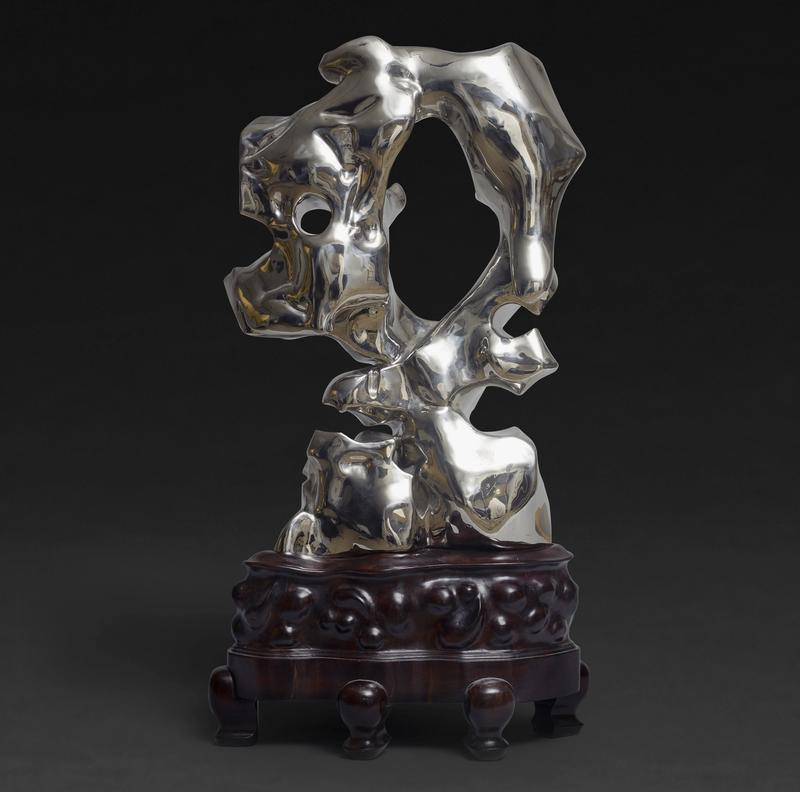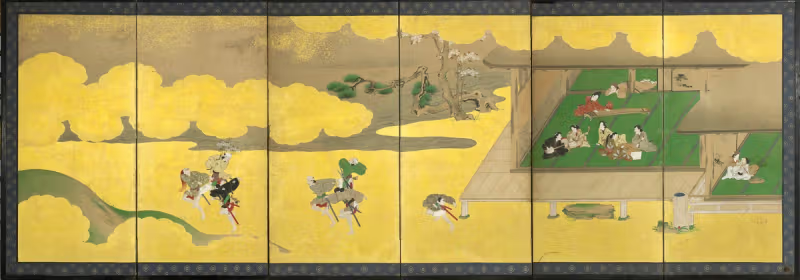A kakemono by Otagaki Rengetsu
Otagaki Rengetsu (1791-1875) and Wada Gozan (1800-1870)
A kakemono (hanging scroll) executed in ink on paper with a painting of trees beneath the moon which is paired with a poem referring to a cuckoo's song and the setting moon.
This scroll is a collaboration between two artists, with calligraphy by Otagaki Rengetsu and painting by Wada Gozan.
Calligraphy signed Rengetsu; painting sealed Shuku
Japan 19th century Edo period
Tomobako (wooden box), inside lid inscribed with possibly a collector’s name Kanjuan Chinka? with a seal. A paper inside the box inscribed Kyoto Yamamoto Yokodo kinso [mounted by Yamamoto Yokodo in Kyoto]
Hototogisu
ima hitokoe to
machishi ma ni
shirami hatetaru
ariake no tsuki
While I wait to hear
one more song of
the little cuckoo,
dawn is breaking
and the moon comes to fade
Otagaki Rengetsu composed this verse from the perspective of a traveller who was cold-heartedly rejected at an inn. Unable to sleep under a roof, she had to sleep outside. Seeing cherry blossom in full bloom under the moonlight, she interpreted her situation as an unexpected gift. This is one of the most representative poems by Rengetsu as there are multiple ceramic works and paintings with this poem known.
Rengetsu was in her lifetime a Buddhist nun, poet, calligrapher, potter and painter. Shortly after her birth in Kyoto to a samurai family with the surname Todo, she was adopted by Otagaki Mitsuhisa who worked at Chion'in, an important Jōdo (Pure Land) sect temple in Kyoto, and was given the name Nobu.
In 1798, having lost her mother and brother, she was sent to serve as a lady-in-waiting at Kameoka Castle in Tanba, where she studied poetry, calligraphy and martial arts, returning home at the age of 16 to marry a young samurai named Mochihisa. They had three children, all of whom died shortly after birth; in 1815 Mochihisa also died.
In 1819 Nobu remarried, but her second husband died in 1823. After enduring the tragic loss of two husbands and all her children, Nobu, only 33 years old, shaved her head and became a nun, at which time she adopted the name Rengetsu (Lotus Moon). She lived with her stepfather, who had also taken vows, near Chion'in. After his death in 1832 Rengetsu began to make pottery, which she then inscribed with her own waka (31-syllable classical poetry) and sold to support herself.
In 1875, having led a long and exceptional life, Rengetsu died in the simple Jinkōin tearoom in Kyoto where she had lived and worked for ten years. Jinkōin Temple is a Shingon School temple (Esoteric Buddhism); Rengestu was ordained as a nun in the Pure Land School (Jōdo Shū) but she also studied and practiced Zen and Esoteric Buddhism.
The delicate hand-built tea utensils that Rengetsu inscribed with hauntingly beautiful poems are unique combinations of poetry, calligraphy and pottery; they were as highly prized in her own lifetime as they are now. Rengetsu is also known to have inscribed her poems on utensils made by other Kyoto potters. In addition to ceramics, she also produced numerous gassaku (jointly created artworks) in the form of paintings, hanging scrolls, and calligraphic works with fellow literati artists and writers.
This hanging scroll is a collaboration between Rengetsu and her close friend, Wada Gozan. Gozan was a monk and painter of the late Edo period. He was originally from Osaka, but at the age of 42 he lost his wife and became a priest in Kyoto, taking the Buddhist name Gesshin (Moon mind). He later became the chief priest of Jinkōin Temple where Rengestu lived in her later life. Gozan took on the successive monk names of Gesshin, Ashuku and Kūsō. The seal on this painting reads ‘shuku’, which is taken from his monk name ‘Ashuku’.
As an artist, Gozan studied under Mori Tetsuzan (1775-1841), an accomplished Maruyama-Shijō School painter in the line of Maruyama Ōkyo. Gozan’s master, Tetsuzan, died at around the same time as Gozan’s wife passed away, no doubt influencing his decision to join the temple in Kyoto. During a time of famine, Gozan drew pictures of the bodhisattva Kannon, the Buddhist embodiment of compassion, and sold them to provide food to the poor. On another occasion, Rengetsu and Gozan also created 100 images of Kannon to support victims of flood. Though primarily a painter, Gozan also wrote waka poems.
Works by Rengetsu can be found in the collections of various museums including: The Tokyo National Museum; The Metropolitan Museum of Art, NY; the Michigan Museum of Art; Los Angeles County Museum of Art; Smithonian’s National Museum of Asian Art, Washington DC; Asian Art Museum, San Francisco; Art Gallery of South Australia, Adelaide; Museum of Far Eastern Antiquities, Stockholm.
For more details of Rengestu and her works, see:
Frank Feltens, ed., Japan in the Age of Modernization: The Arts of Otagaki Rengetsu and Tomioka Tessai, (Washington, D.C., 2023);
National Gallery of Australia ed., Black Robe White Mist: art of the Japanese Buddhist nun Rengestu, (Canberra, 2007).



















